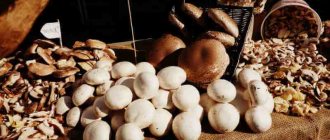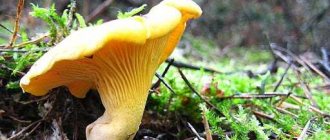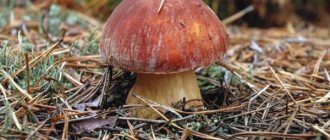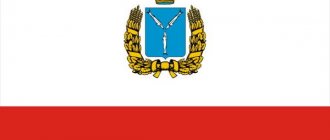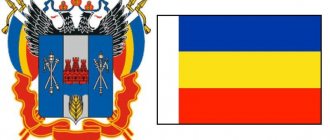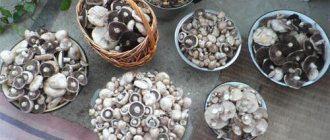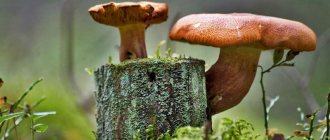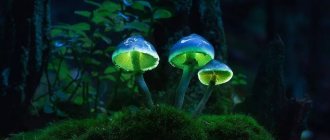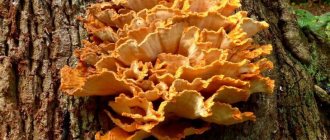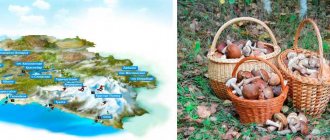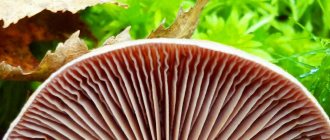Do you like mushrooms?
They can be used to make many wonderful dishes. And when gathering, you can enjoy the tranquility of the atmosphere and take a break from the tired bustle of the city.
The beauty of the surroundings of Crimea is amazing, so the “silent hunt” will be especially picturesque. Moreover, on the territory of the peninsula there is a huge number of different types of mushrooms, from which you can choose the ones you like best, so the search will not only be a delight for the eyes and soul, but also productive.
Even experienced mushroom pickers sometimes make mistakes, so it would be a good idea to get additional information before traveling to this mushroom region.
Mushrooms of Crimea
Crimea has quite unusual climatic conditions, due to this, in one part of the peninsula there may be an absolute crop failure of mushrooms, while in another there is an abundance of them. Many will find it interesting that mushrooms appear not only in the forest: some grow in the steppes, fed by black soil rich in nutrients, and some in mountainous areas at an altitude of about 1.5 km above sea level. There are about 100 species on the peninsula.
Expert opinion
Melnikov Vladimir Mikhailovich
Knows 1000 ways to cook, pickle and marinate any types of mushrooms
The picking season opens in early spring and ends in late autumn, that is, mushrooms are visible as soon as the snow melts and when it falls again.
What time and what kind of mushrooms are collected in Crimea?
The fruiting period of most species is not limited to one time of the year, stretching over several months. But peak yield usually occurs in only 5-8 weeks.
Description of summer species
In summer in Crimea you can find many mushrooms of the following types:
- Mountain white mushroom (giant talker). The fruits are very large, up to 30 cm in diameter. As the fungal organism matures, the cap transforms from a smooth depressed one to a cracked funnel-shaped one. Short and thick smooth legs are visible under the caps. The color of the fruit is uniform, white or cream. The hollow in the center of the cap is highlighted in a darker tone.
- Caesar's (Caesar's) mushroom, or Caesar's fly agaric. A rare mushroom listed in the Red Book of Crimea. Young fruits have an egg-shaped or hemispherical cap of bright orange color. In adult mushrooms, the cap takes on a prostrate shape and fades to yellow. There is a yellow mushroom ring on a strong club-shaped stalk of golden color.
- Milk mushrooms. Medium-sized fruits with flattened caps, in the middle of which there is always a pronounced hollow. The legs of milk mushrooms are cylindrical and always repeat the color of the cap, which can be expressed in different shades of white, yellow, brown, gray, pink, purple, black and even blue. Some varieties have variable colors. The pulp of milk mushrooms smells like fruit and has a spicy peppery taste.
- Rogatiki. The fruits have an unusual shape. Rogatiki are more like corals than mushrooms. In the Crimean lands, only yellow and bunch varieties are common. Yellow Hornbills are characterized by color variability. Young fruits are colored lemon or cream, while old ones change their color to ocher or orange, respectively. The branches of cluster hornets are painted with a brownish tint of cream color, and a brick-brown tint appears at their tips.
- White dung beetle (ink mushroom). A dark tubercle stands out on the snow-white fusiform or bell-shaped cap of the dung beetle. Under the cap there is a tall and thin white stem with a movable ring. In cooking, only young mushrooms with white plates are used. In mature dung beetles, the cap is transformed into an ink mass - this is a unique way of spreading spores.
Most species actively bear fruit in the second half of summer.
Names of autumn varieties
In autumn, mushroom pickers go for the following species:
- Saffron milk caps. Large fruits with convex orange caps, which over time transform into funnel-shaped ones. The legs of saffron milk caps are smooth, slightly thickened at the bottom. The entire surface of the leg is covered with small dimples. The cap usually has a pattern of dark concentric circles and spots. A characteristic feature of camelina is the presence of milky juice. It is initially orange, but turns green when exposed to air. The same variability is characteristic of the pulp of red mushrooms.
- Butter. Slippery mushrooms with an oily film on the surface. Young butterflies have convex caps, while old ones have slightly flattened caps. The legs are club-shaped. The color of the oiler depends on what species it belongs to. Its fruiting body is always uniformly colored, yellow, orange or brown. A dark ring clearly stands out on the stem. The flesh of butternut squash is light and, depending on the variety, it may turn blue or red when cut.
- Raincoats. Large white fruits, the surface of which is covered with a layer of spiny scales. The mushroom bodies are entire, the stalk is missing. Instead, a pseudopod stands out, which is actually a continuation of the cap. These mushrooms tend to burst after ripening to erupt spore powder. Giant and pear-shaped varieties of puffball are common in Crimea.
What mushrooms grow in October
Peak fruiting of some mushroom species occurs in October:
- Little mice or gray rows. The fruits grow small. Depending on the period of development, they may have bell-shaped or prostrate caps with smooth or cracked edges. There is always a noticeable tubercle in the central zone of the cap. The legs are thin, long, often curved. The fruits are colored in light shades of gray. The cap part is usually darker. Radial stripes may appear on it. The flesh of young mice exudes a pleasant aroma of freshly ground flour. With old mushrooms, this smell becomes musty.
- Chanterelles. Orange mushrooms with slightly flattened funnel-shaped caps, the edges of which are turned down. Rows of plates run from the cap to the stem. The base of the leg is narrowed. When pressed, it acquires a reddish tint. A characteristic feature of chanterelles is the smooth transition of the cap to the stem. Visually it is very difficult to distinguish them.
- Oyster mushrooms (common oyster mushrooms, lumps). Lush clusters of fruits with funnel-shaped ear-shaped caps on short and crooked lateral stalks. The surface of oyster mushrooms is matte, gray. Depending on the conditions of development of the mycelium, the color of its fruits can be expressed in any shade of gray, not even excluding a metallic tint.
In warm autumn, mushrooms can be found even in November.
Edible mushrooms
Crimea has a huge number of edible species that grow in different zones. For your own safety, you should familiarize yourself with the most common mushrooms in the area you have chosen to collect them.
Common chanterelle
Forest species
- Chanterelles.
They grow in small groups in shady places in the forest.
Their distinctive feature is their shape and color: chanterelles are yellow (or orange) in color with concave caps and wavy edges (there is no noticeable transition from cap to stem). When pressed, the flesh turns red.
Chanterelles contain many vitamins, ergosterol, which has a beneficial effect on the liver. They will also help remove worms.
- Milk mushrooms.
Real milk mushroom
There are no real milk mushrooms in Crimea, but there are peppery and dry ones. The first can be distinguished by a concave white cap and bitter milk, which is released when the plates are broken. There are brown spots on the cap of a dry milk mushroom, and the plates have a bluish tint and do not secrete milk.
They grow mainly in mixed forests.
Breast milk is perfect for pickling and pickling. Before cooking, you need to soak it in water several times.
- Saffron milk caps.
They grow in large groups in shady and damp places.
Saffron milk caps have a slightly sticky orange cap, red plates and dense flesh with a fruity smell that turns green when pressed. Their legs are hollow and reach 2 cm in diameter.
Ryzhik
Expert opinion
Melnikov Vladimir Mikhailovich
Knows 1000 ways to cook, pickle and marinate any types of mushrooms
Ryzhiki can be prepared in different ways: frying, pickling, boiling, salting and drying.
- Honey mushrooms.
honey mushrooms
Honey mushrooms grow on fallen trees and stumps in whole families.
Their stem and cap are the same color ─ honey ─ they are covered with dark scales, which is why they appear fluffy and brown. He also has a “skirt” under his hat.
Like saffron milk caps, honey mushrooms can be prepared the way you prefer. They can be added to dishes as a seasoning, as they are quite aromatic.
- Rogatiki.
Rogatik pistil
Rogatik is difficult to confuse with any other, it looks like coral.
It has neither a cap nor a stem; the horntail consists of a branched fruiting body. Its flesh is moist and dirty white; if you press on it, it will turn red.
Young mushrooms are used for food. They can be fried, pickled or added to soup.
Steppe
- Morels are marsupials.
Grow in areas of fires, in mixed and deciduous forests
They have a rather unusual shape: cellular, egg-shaped caps of a brownish color, hollow legs. The flesh is white and breaks easily.
Morels have a distinct mushroom smell and a pleasant taste.
Steppe morel
- Champignon.
Champignon
They grow in groups both in forests and steppes, forming a ring.
These are mushrooms with a large smooth cap of white, brown or brown color and a “skirt” on the stem. When cut, their flesh turns red.
Great for frying.
- Raincoats.
Pear-shaped raincoat
It is considered a delicacy in European countries.
You can find a raincoat in a deciduous or coniferous forest; there are really a lot of them in the steppes. It reaches a height of 35 cm. At first glance, the needle-shaped white cap (it can be rough or pear-shaped) and the short massive leg catch the eye.
Be sure to pay attention to the density and color ─ it should be dense and completely white, if you eat another, you risk getting poisoned.
Young puffballs are used for cooking and the skin should be removed. The best option would be frying or drying.
Mountain mushrooms
- Porcini.
Porcini
The most common in the mountains of Crimea.
They grow in groups, which are quite easy to spot due to the large pale brown caps that reach 20 cm in diameter.
A mushroom is considered fresh if it is entirely white.
White is very useful, as it contains antibiotics that fight tuberculosis.
You can cook it however you want, it tastes good in different dishes.
- Rows.
Ryadovka
In another way they are called “little mice”. They are quite difficult to distinguish from poisonous species, so you should be especially careful when collecting them.
The rows have a flat grayish cap with a tubercle at the top, curled at the edges, and the stem is dense, pale yellow; by the time it ripens, it becomes hollow.
The pulp is dense, but brittle and has a mealy odor.
Before cooking, it is advisable to soak the mice in brackish water with the addition of citric acid.
Precautionary measures!
Before planning a route and going on a quiet hunt, beginners who have just become interested in the thrill of quiet hunting are advised to carefully study the distinctive features of edible and poisonous mushrooms. Important information with visual photos will protect young mushroom pickers who have no experience from poisoning and possible death if they refuse to provide first aid.
Saffron milk caps, where do they grow?
Delicious saffron milk caps with a captivating mushroom aroma are quite easy to detect. If you want to reap a good harvest, a mushroom picker should go searching in the coniferous forest zones of Sevastopol with a mound of sawdust on fertile soil.
The day for searching for mushrooms should be chosen based on the weather. The harvest depends on the level of humidity. From the moment of rain, 5 to 8 days must pass so that the fruits have time to grow and become ready for collection in wicker baskets or buckets.
It is quite easy to confuse saffron milk caps with talkers due to ignorance of the distinctive characteristics. To avoid negative experiences and harm to your health, you should spend enough time studying the signs and differences that separate edible fruits from poisonous ones.
Compared to other edible mushrooms, regardless of age, the flesh of saffron milk caps is not susceptible to penetration by worms that attack the fruit from the inside. When collecting full baskets, the product can be frozen, fried or stored for the winter without discarding spoiled mushrooms.
Honey mushrooms, where do they grow?
Honey mushrooms are weeds that reproduce in a controversial manner over large areas. Due to the large number of subspecies, mushrooms can be found almost anywhere, regardless of the time of year. They sprout both on trees and dried stumps, and on open ground sprinkled with leaves or sawdust.
Boletuses and boletuses, where do they grow?
The noble family of bees, as their name suggests, can be found in plantings of birch and aspen trees. Mushroom germination occurs throughout the warm season, when the air temperature does not exceed 25 degrees.
Active fruiting begins in spring and autumn, in summer, a decrease in fruiting is observed due to increased air temperature and minimal precipitation. Due to the hot summer in June, July and August, fruits may be affected by the worm.
When looking for boletus and boletus mushrooms, beginners should know that mushroom stems are preferred for pickling, and caps for frying. The different structure of the upper and lower parts does not allow the entire mushroom to be used for preparing single dishes.
Butterflies, where do they grow?
You can find boletus in spruce plantings, in the same place where saffron milk caps and saffron mushrooms sprout. Mushroom picking occurs in two seasons: spring and autumn. In April and May, mushrooms are suitable exclusively for frying due to the small volume of the harvest, and in the autumn - for harvesting for the winter. Peak growth is September.
Little mice, where do they grow?
Another mushroom that prefers coniferous forest belts is mice. Occasionally they can be found on mountain slopes. The coloring of the fruits often resembles stones, allowing the fruits to easily camouflage themselves in the area.
Picking mushrooms in Sevastopol in 2022 is not as difficult as it seems at first glance. A mushroom map of the best places, combined with real reviews, will speed up your search, reducing the time of quiet hunting by several times.
Inedible
Before going into the forest, you should find out not only about edible, but also about poisonous mushrooms, because most of them have quite strong toxins. Therefore, one mistake can cost you your life:
Fly agarics
Very bright and noticeable: a bright red cap with white specks (up to 20 cm in diameter) stands on a long white stem with a “skirt” (up to 20 cm in height).
This beautiful plant grows in mixed forests and prefers acidic soil.
fly agaric
False honey fungus brick-red
False honey
It is similar to edible honey mushrooms, but if they are mixed up, it can be fatal.
Just like ordinary honey mushrooms, they grow in groups on fallen trees or stumps, but false honey mushrooms are sandy in color and do not have a fluffy cover.
False chanterelles
A yellowish lookalike of the real chanterelle. Very poisonous.
The real cap has wavy edges, while the false one has uneven edges, and the cap itself in the center is darker than at the edges.
False chanterelle
Tiger row
A poisonous analogue of baby mice.
They grow in groups (“witch rings”) mainly in coniferous forests
The cap of the tiger row is scaly, convex with thin, downward-sloping edges (5-10 cm in diameter), it can be dirty white and silver in color, and the cylindrical leg can reach 12 cm in height.
Champignon dark scale
Grows in deciduous forests, on compost heaps and on rotting straw.
The false champignon has a brownish cap with scales and a long, smooth stem. Its plates are gray-pink in color; when the mushroom is fully ripe, they become brown in color.
It differs from edible in that it does not change color when cut.
Toadstool pale
Death cap
Eating toadstool risks sudden death, as it is very poisonous.
Its cap is grayish or greenish. At first it resembles a hemisphere, and as the mushroom matures it becomes flat. Stands on a white leg with a “skirt”.
Satanic mushroom
It grows in deciduous forests next to oak, hornbeam or beech.
They have a recognizable appearance due to their barrel-shaped legs with a red rim in the center.
Its flesh is white or yellowish in color; after cutting, it turns blue or red.
Satanic mushroom
It is noteworthy that young mushrooms have a spicy smell, while more mature ones smell like rotten onions.
Omphalotus oleifera
It prefers the stumps of olive trees (which is why it is called “olive” or “olive”). Tends to form colonies.
Olive omphalot is poisonous. Contains a dangerous toxin - muscarine. Victims usually recover within 24 hours, but severe cases can result in death due to respiratory failure.
Omphalotus oleifera.
Inedible and poisonous species
The variety of inedible species also amazes even experienced mushroom pickers. In addition to fly agarics, there are also those that very skillfully disguise themselves as healthy and tasty. These are several types of row mushrooms, champignons and talkers, as well as false honey mushrooms and pale toadstools. The most common types are:
- The toadstool is deadly.
It is often confused with champignon. A characteristic feature of the toadstool is the white “skirt” on the leg. The champignon also has the same ring, but it differs from the toadstool in that the plates on its cap darken in adult mushrooms. Pale toadstool The same applies to other lamellar mushrooms, similar to this poisonous mushroom, but without “skirts”. The color of the toadstool itself is from gray to green, the cap is hemispherical, and becomes round as it matures. It is often confused with green russula. But a ring on the stem, white scales and thick plates are sure signs of a deadly mushroom. - White fly agaric is a deadly mushroom. It can be recognized by the ovoid “decoration” at the bottom of the stem.
White fly agaric - False foam is another life-threatening mushroom. It differs from the real one in the absence of a ring on the stem.
- The whitish talker may resemble a Polish mushroom. The sign that determines “toxicity” is a powdery coating on the cap. The talker is whitish
- The poisonous purple boletus is distinguished by a large, irregularly shaped cap, upon which black and dark blue spots appear when pressed.
- The darkening of the cap when pressed characterizes the pink wave. And the hat itself is quite unusual. It is slimy to the touch, flat with a small depression in the src=»https://ogorod-bez-hlopot.ru/wp-content/uploads/2018/12/Lactarius-torminosus-005.jpg» class=»aligncenter» width= "1200″ height="800″[/img] Pink Volnushka
- The false chanterelle differs from the real one by having a thinner red leg with a brick tint and a rather unpleasant odor.
- Gorchak is the most popular dangerous mushroom in Crimea. There is controversy among scientists about the safety of gall fungus. However, due to its very bitter taste, this fruit cannot be eaten. For such qualities they gave it a second name - bitterling.
Gorchak
Mushrooms listed in the Red Book
- Geopora cooperi - Cooper's Geopora.
- Tuber aestivum - Summer truffle.
- Agaricus bernardii - Bernard's champignon.
- Agaricus kuehnerianus - Kuehner's champignon.
- Agaricus macrosporus - Large-spored champignon.
- Agaricus tabularis - Table champignon.
- Montagnea arenaria - Sandy Montagnea.
- Amanita caesarea - Caesar's fly agaric.
- Amanita vittadinii - Amanita Vittadini.
- Pleurotus nebrodensis - Nebrodsky oyster mushroom.
- Floccularia luteovirens - Yellow-green floccularia.
- Phaeolepiota aurea - Golden phaeolepiota.
- Boletus aereus - Bronze boletus.
- Boletus pulchrotinctus - Beautifully colored boletus.
- Boletus regius - Royal boletus.
- Boletus rhodoxanthus - Pink-golden boletus.
- Pisolithus arhizus - Pisolithus rootless.
- Geastrum fornicatum - Vaulted starweed.
- Geastrum melanocephalum - Black-headed starfish.
- Myriostoma coliforme - Myriostoma cervical.
- Clavariadelphus pistillaris - Clavariadelphus pistillaris.
- Ramaria botrytis - Ramaria botrytis.
- Clathrus ruber - Red trellis.
- Ganoderma lucidum - Lacquer tinder fungus.
- Grifola frondosa - Curly Grifola.
- Polyporus rhizophilus - Root-loving tinder fungus.
- Polyporus umbellatus - Polyporus umbrella.
- Sparassis crispa - Curly Sparassis.
- Hericium coralloides - Coral-shaped Hericium.
- Hericium erinaceum
- Lactarius chrysorrheus - Golden yellow breast.
- Lactarius sanguifluus - Blood red camelina.
- Boletopsis leucomelaena - White and black Boletopsis.
Varieties of Crimean champignons
Champignons are called lamellar mushrooms with fleshy, rounded, outstretched caps on smooth, ringed stalks. In mycology, more than 200 types of champignons are distinguished, the vast majority of which are edible. Only 4 types of these mushrooms are common in Crimea.
Ordinary
Pecheritsa are characterized by hemispherical or rounded-spread convex caps with a dry silky surface, an even cylindrical stem with a white mushroom ring. The color of the fruit is uniform, it can be white or brownish. The flesh of an ordinary champignon is white, but when damaged, the fracture site acquires a reddish tint.
Field
Depending on the age of the fruit, the cap of the field champignon can be rounded-bell-shaped with a tucked edge or convex-spread with a central tubercle and wavy edges. The surface of the cap is painted white or cream. Over time, it acquires an ocher tint.
When pressed, the cap turns yellow. The color of the leg matches the color of the cap. The pulp is white (yellowish), dense, fleshy. It gives off a pleasant anise smell.
Darkscale
Poisonous champignon. It is distinguished by its relatively small fruit size. The shape of the cap varies from hemispherical or bell-shaped to convex-spread. The surface of the cap can be white or brownish. There is always a row of dark scales on it. The leg is thickened at the base. The white flesh turns yellow when exposed to air.
Flat-hat
Variegated champignons are inedible. Hats can have a convex or flattened shape depending on age. The base of the leg is swollen. The fruiting bodies of young mushrooms are painted white.
As they age, the color of the leg changes to yellow, then brown. The cap remains white, but its surface is covered with a layer of dark scales, which form a kind of motley pattern. The mushroom ring is also covered with scales. The flesh of the flat-capped champignon emits an unpleasant odor.
Mushroom places
On the peninsula they grow almost everywhere, but there are certain places where they are most numerous:
- In search of chanterelles, you should look into the Simferopol region. Their accumulation is observed near the village of Mramornoe. Also, red beauties grow in the forests of Belogorsk, Kirov, and Bakhchisarai regions.
- To hunt for saffron milk caps, you should go to the village of Rybachye or to the forests of the southern coast of the peninsula.
- Porcini mushrooms, like other mountain mushrooms, are especially abundant on the Ai-Petri plateau and in the foothills of Demerdzhi.
The rest of the mushrooms are distributed almost everywhere, but here are the most popular places for “silent hunting”:
- near the village of Luchistoye;
- steppes;
- Mount Demerdzhi;
- on the road from Sevastopol to Bakhchisarai;
- territory from Feodosia to St. Crimea.
Where do mushrooms grow in Crimea and how to distinguish good mushrooms from poisonous ones?
The unique climate of Crimea and the soil, rich in organic matter, create excellent conditions for the growth of mushrooms. The interesting thing is that they can be found everywhere - in the mountains, in forests and in the steppe zone. This article will help you figure out which edible and which poisonous mushrooms grow in Crimea. She will also share delicious recipes for pickling Crimean mushrooms.
What mushrooms are edible in Crimea?
Fans of mushroom “hunting” get the greatest pleasure on the Crimean Peninsula. According to statistics, up to two hundred species of mushrooms grow in Crimea. Of these, about 100 species are suitable for consumption. It is interesting that local mushroom pickers collect no more than 40 species of mushrooms. The rest of the potential remains unclaimed.
Mushrooms in Crimea
Local “mushroom hunting” professionals give preference to porcini mushrooms, boletus mushrooms, boletus mushrooms, boletus mushrooms, chanterelle mushrooms, saffron mushrooms, champignons and honey mushrooms. Although the list of edible mushrooms is much longer. So, it is replenished with baby mice, early single-barrel mushrooms, milk mushrooms, mountain mushrooms, puffballs, russula, green moss mushrooms, oyster mushrooms, row mushrooms and morels.
Where do Crimean mushrooms grow?
Crimean mushroom pickers say that: - there are a lot of mice in the village of Kolchugino ; — boletus grows Strogonovka and Zelenogorsk — Chanterelles are collected in Mramornye ; — rows are growing the astrophysical observatory — in the Demerdzhi and the forests of Radiant, different types of mushrooms grow.
The forest zone from Feodosia to Old Crimea is rich in mushrooms. Mushroom pickers also love the territory from Sevastopol to Bakhchisarai. In the steppe zone of the Donuzlav and Sasyk estuaries, mushrooms are also found after rain.
Mushrooms in the forests of Crimea
Most of the mushrooms in Crimea grow in forests and forest-steppe areas. Their collection begins in early spring. So in deciduous and also coniferous forests you can find the Crimean porcini mushroom, while the little mice hide in the moss.
Note: in the forests of Simferopol, Bakhchisarai, Belogorsk and Kirov regions there are many chanterelles, honey mushrooms often settle on stumps. There is a lot of butter in the forests of the Belgorod region, in the villages of Zelenogorskoye and Stroganovka.
Milk mushrooms grow in mountain and foothill forests. In the forests of the southern part of Crimea, saffron milk caps are often found.
Edible mushrooms of Crimea: photos, description
From the huge list of edible mushrooms found in Crimea, we can highlight the most popular among mushroom pickers. This:
- Crimean white mushroom (its second name is giant talker). Grows in groups under pine and birch trees. It is difficult to confuse it with others, since it is a white mushroom, the cap of which is smooth white or with a coffee tint, and the stem is thick and short.
Crimean white mushroom
- gray row (such mushrooms are also called little mice). Their cap is conical in shape with a tubercle in the center, the edges are uneven, slightly curled. Cracks may be visible. The leg is dense. On the sticky caps of such mushrooms you can often see lumps of forest debris stuck to them.
Gray row in Crimea
- chanterelles (their second name is cockerels). The main feature of this mushroom is the absence of a transition from the stem to the cap. They are yellow or orange in color.
Chanterelles in Crimea
- autumn honey mushrooms. This mushroom has a honey color. The hat is wrapped inward, with dark scales scattered across it.
Crimean autumn honey mushrooms
- common boletus. The peculiarity of this light brown mushroom is its fleshy, slippery cap.
Common boletus in Crimea
- pepper milk mushroom. It is distinguished by a large cap with gray spots and a depression. The short stem of such a mushroom is narrowed at the bottom.
Pepper milk mushroom
Poisonous mushrooms of Crimea: photographs, description
Picking mushrooms in Crimea brings a lot of pleasure to mushroom pickers, thanks to the fact that they very often find real “trophies”. But, unfortunately, sometimes there are cases when a tasty mushroom turns out to be poisonous and its entry into the body provokes severe poisoning and death. To avoid encountering such a mushroom and eating it, experts recommend knowing which mushrooms in Crimea are dangerous to health.
1. The list of mushrooms that can kill you includes:
- pale toadstool (it looks like a champignon, as well as russula);
- lepiota brown-red (does not resemble edible mushrooms);
- white spring fly agaric (similar to pale toadstool);
- sulfur-yellow false honey fungus (similar to meadow and autumn honey mushrooms).
2. The list of fungi that affect the nervous system includes:
- whitish talker (similar to honey mushroom and meadow honey);
- fissured fiber (resembles May row);
- red fly agaric (does not resemble edible mushrooms).
3. The list of fungi that affect the gastrointestinal tract includes:
- purple boletus (has no resemblance to edible mushrooms);
- pink trumpet (can be confused with spiny milkweed and saffron milk);
- false chanterelle (looks like a chanterelle);
- white row (can be confused with gray row);
- satanic mushroom (similar to the well-known porcini mushroom);
- dark-scaled champignon (similar to forest champignon).
Mushroom season: picking by month
The peninsula's changeable weather conditions make it difficult to say exactly when the mushroom season begins. It usually happens like this - in one area of the peninsula no one even remembers mushrooms, but in another part, where the snow has slightly melted, the “mushroom hunt” begins in full swing. An important feature of the region is the growth of mushrooms both in forest zones and in steppe soils rich in organic matter.
“Silent hunting” in Crimea begins in the first months of spring and ends in the last months of autumn. Thus, marsupial morels, bigheads and puffballs appear immediately after the snow has melted.
In the summer you can find more than a hundred species of mushrooms. However, avid Crimean mushroom pickers prefer:
- Mountain porcini mushroom . It can be found in forests from June to October.
- To little mice . They grow in forests, as well as on crumbly sandy soil, and are found in early to mid-autumn season.
- Chanterelles . They choose places in sunny meadows and clearings, near birch, spruce and pine trees. Chanterelles are collected from June until the first frost.
- Honey mushrooms in autumn . Found everywhere from September to November.
- Ordinary butter . They are found everywhere and begin to be collected by mushroom pickers from June to October inclusive.
- Milk mushrooms . They grow in forests and are found all summer.
- To the saffron milk caps . They are always found in the forest zone from mid-summer.
How to distinguish good mushrooms from poisonous ones
Warm and rainy weather opens the “silent hunting” season. However, for some mushroom pickers it ends in poisoning or even death. To prevent this from happening and to prevent a poisonous, life-threatening mushroom from ending up on your plate, you should carefully study the differences between edible mushrooms and false poisonous ones. Let's look at some of them.
Among all the poisonous mushrooms, the most dangerous mushroom should be highlighted - this is the well-known toadstool. Its appearance is similar to honey mushroom, champignon and russula. This mushroom is very dangerous, since there is no antidote to the amantine toxin it contains.
You should know that the champignon, unlike the toadstool, has brown or pink plates under its cap. The grebe is characterized by white plates. The cut of the champignon pulp turns slightly red or yellow. The flesh of the poisonous mushroom does not change color. The smell of champignon has notes of almond or anise. The pale toadstool does not smell of anything.
The most easily recognizable of all poisonous mushrooms is the fly agaric. It cannot be confused with edible mushrooms thanks to its beautiful red cap strewn with white specks.
Symptoms of mushroom poisoning
Mushroom poisoning causes damage to many vital organs. Let's take a closer look at how this manifests itself:
1. The gastrointestinal tract is affected . Periodic painful contractions appear in the abdominal area (up to 25 times a day), the temperature rises greatly, stool becomes loose and frequent, incessant nausea and vomiting occurs, and the extremities become cold. In case of poisoning with toadstool, blood appears in the stool, and the vomit takes on the color of coffee grounds.
2. The central nervous system is affected. Disruption of the nervous system may have different symptoms depending on the type of mushrooms eaten.
Thus, from the use of fly agaric, hallucinations appear and physical arousal is noted. Then the activity turns into restlessness, clumsiness and apathy. Subsequently, loss of consciousness may occur. 3. When poisoned by false honey mushrooms a person begins to delirium , his behavior may even border on insanity. 4. Heart function is disrupted . There is a decrease in blood pressure, the pulse quickens. 5. The functioning of the kidneys and liver is impaired .
The degree of damage will depend on the amount of poison entering the body. At an early stage, oliguria is observed (decreased urine volume). Then liver failure develops, brain function is disrupted, and jaundice is diagnosed. Severe intoxication can lead to hepatic coma, and kidney damage can lead to acute renal failure. Canned mushrooms can lead to botulism. The spore-bearing bacilli of the pathogen usually sit in the soil and may end up on mushrooms. Therefore, poorly washed canned mushrooms become the cause of the disease.
When processed at home, the spore-bearing bacillus does not always die, but in a sealed jar without oxygen it receives favorable living conditions. Botulism appears 12 to 72 hours after eating mushrooms.
Botulism manifests itself as follows: vision is impaired (the picture is double), pain in the head appears, dry mouth and nausea with vomiting appear, it becomes difficult to swallow saliva, and convulsions appear. If you have 2 symptoms after taking mushrooms, you should urgently call an ambulance and not resort to self-medication.
The most delicious recipes for pickling Crimean mushrooms
Recipe 1. Pickled chanterelles
Ingredients: mushrooms (5 kg), water (2 liters), salt (70 g), bay leaf (5 pcs.), sunflower oil (20 ml), sugar (40 g), cloves (10 pcs.), peppercorns (10 pcs.), vinegar (100 ml). Preparation: 1. Peeled mushrooms are filled with water and cooked for 20 minutes. 2. Mushrooms are removed from the water and washed. 3. The volume of water is added to 2 liters. 4. Add salt, sugar, as well as pepper and cloves. 5. Diced onions and chopped garlic into slices are added to the marinade. 6. Add oil and also vinegar. Cook for no more than 3 minutes. 7. Add boiled mushrooms to the solution and boil for 12 minutes. 8. Place mushrooms in sterile jars, roll them up with sterile lids and wrap them for 1 day.
Pickled chanterelles
Recipe 2. Marinated white mushrooms
Ingredients: mushrooms (1 kg), water (2 cups), salt and sugar (1 tbsp each), vinegar (3 tbsp), peppercorns (5 pcs.), cloves (3 pcs.), bay leaf (1 pc.). Preparation: 1. Washed mushrooms are cut into small pieces. 2. Pour in water and cook for 15 minutes, skimming off the foam. 3. Take out the mushrooms, wash them, and wait for the water to drain. The marinade is prepared as follows: salt, sugar, pepper, cloves, and bay leaf are mixed with water. Boil all this for 5 minutes, adding vinegar. Mushrooms with marinade are placed in sterile jars and sealed with sterile lids.
Marinated porcini mushrooms
Recipe 3. Marinated boletus Ingredients: collected mushrooms (1.5 kg), water (0.5 l), table vinegar (70 ml), salt and sugar (1 tbsp. each), bay leaf (3 pcs.) , black peas (6 pcs.). Preparation: 1. Boil peeled and washed mushrooms for 15 minutes. Drain the water and boil again for 15 minutes in new water. 2. The water is drained through a sieve. The marinade is prepared as follows: boil water with all the spices for 5 minutes. Add mushrooms and boil for another 10 minutes, adding vinegar and boiling for 3 minutes. 3. Mushrooms are placed in prepared sterile jars, rolled up with metal lids and wrapped for one day.
Marinated boletus
Now you know what mushrooms grow in Crimea and you can distinguish edible mushrooms from dangerous poisonous ones. Use the recipes for pickling Crimean mushrooms suggested in the article and enjoy your own homemade preserves!
- Related Posts
- How to travel by train to Crimea correctly: carrier recommendations
- How to order goods from Aliexpress to Crimea?
- Simferopol Airport: how to get to the center and the coastal cities of Crimea
Your comment Cancel reply
Time to pick mushrooms
In Crimea, they can be collected from March to December, but in order not to be disappointed when you come to the forest for a specific type of mushroom, you should familiarize yourself with this table:
| Name. | March. | April. | May. | June. | July. | August. | September. | October. | November. | December. |
| The champignon is browning. | ||||||||||
| White. | ||||||||||
| Mountain white. | ||||||||||
| Raincoat. | ||||||||||
| Chanterelles. | ||||||||||
| Honey mushrooms. | ||||||||||
| Rows. | ||||||||||
| Saffron milk caps. | ||||||||||
| Morels. |
Distribution areas of edible species in Crimea
In Crimea, mushrooms are distributed almost everywhere. But avid lovers of “silent hunting” highlight particularly fruitful areas.
Where to go in the steppe
More than half of the entire territory of Crimea is occupied by the steppe zone. In the bare steppe you can find single-barrel oyster mushrooms. In the dense grass there are myceliums of honey mushrooms, boletus, boletus, boletus, and saffron milk caps. Many steppe mushrooms live near lakes Donuzlav and Sasyk.
Where to collect forest fruits
In the forests of Crimea there are many chanterelles, saffron milk caps, champignons, mice, horned beetles, white dung beetles, boletus, milk mushrooms, and puffballs. Here you can even find a rare caesarean mushroom. The most popular mushroom forest is the Simferopol forest area. The forests of the Bakhchisarai, Belogorsk, and Kirov districts are quite inferior to it.
Stone or mountain mushrooms
Oyster mushrooms and the famous mountain white species, the mushroom heritage of Crimea, grow in mountainous areas. You can also find milk mushrooms here.
The villages of Kolchugino, Mramornoe, Zelenogorskoe, and Stroganovka are considered famous mushroom places in the Crimean mountains. Many mushroom species are common in the Demerdzhi region, at the foot of Mount Ai-Petri, as well as in the districts of the Astrophysical Observatory.
Do bitterlings grow in Crimea?
In terms of distribution area, bitterling is considered a cosmopolitan mushroom. It can be found on any continent, including in the Crimea.
Gorchak belongs to the inedible mushroom category. Its pulp cannot be taken into the mouth due to its strong bitterness, which cannot be removed or masked by any culinary tricks. For this, bitterling received the nickname gall mushroom.
This species is considered a double of several edible varieties. Among them are the most noble porcini mushroom, some boletus mushrooms, and boletus mushrooms.
Advice from experienced mushroom pickers
The first rule of a mushroom picker says that you can only put in a basket those fruits whose edibility does not raise the slightest doubt. It is better to prefer proven mushroom places to spontaneously chosen areas. You can definitely bring a full basket from there.
Advice! It is better to go to the forest early in the morning. The glare of dew will help you find mycelium faster. You should definitely take a sharp knife and a basket with you, or, in extreme cases, a box, since fruits in bags can break.
Some mushroom pickers stubbornly break the fruits out of the mushroom area, despite strong recommendations to use a knife. In this case, the damaged myceliums stop bearing fruit and die.
The Crimean lands abound in a variety of mushrooms. Among them there are both edible and poisonous species. Therefore, it is better to go on your first mushroom picking trips with experienced specialists.
Classification of mushrooms
In total, there are about 14,000 species of mushrooms, which, according to the criterion of edibility, are divided into three groups:
- edible - representatives of the kingdom that are suitable for consumption even without special heat treatment, that is, fresh or dried;
- conditionally edible - mushrooms that can be eaten only after cooking; they are soaked in water and then boiled up to 2-3 times;
- inedible mushrooms are poisonous.
It is important for a mushroom picker to learn how to accurately determine whether a species belongs to a certain classification.
